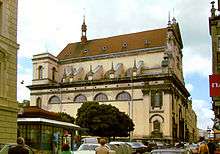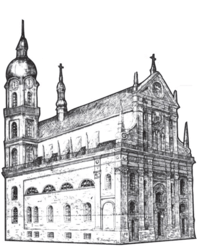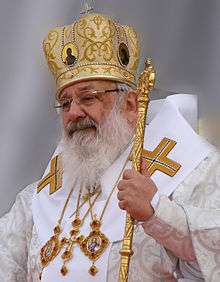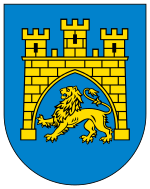Saints Peter and Paul Garrison Church (Lviv)
Saints Peter and Paul Garrison Church (1610-1630) is known to Lviv's residents as the Jesuit Church and was built in the style of early baroque in the beginning of the 17th century. The building resembles Rome's Il Gesù Cathedral and is considered one of the most beautiful religious buildings in Lviv. The church was reopened on December 6, 2011 to celebrate the 20th anniversary of the Armed Forces of Ukraine. The rite of consecration of the church building and the celebration of the first Divine Liturgy was done by Archbishop and Metropolitan of Lviv of UGCC bishop Ihor Voznyak.
| Saints Peter and Paul Garrison Church | |
|---|---|
_02.jpg) The view from Svoboda Avenue | |
| 49.8415°N 24.0291°E | |
| Location | 79000, Ukraine, Lviv, Teatralna St. 11 |
| Country | Ukraine |
| Denomination | Ukrainian Greek-Catholic Church |
| Website | petrapavla |
| History | |
| Founded | 1610-1630 |
| Founder(s) | Society of Jesus |
| Dedication | Saint Apostles Peter and Paul |
| Architecture | |
| Architect(s) | Giacomo Briano |
| Style | Baroque |

History

The year 1540 saw the formation of one of the biggest and most famous communities the Society of Jesus, more known as the Jesuit Order. Within a short time the members of the Society started active missionary work. Jesuits came to Lviv in 1584 and already in 1590 the first wooden church of the Society of Jesus was erected near the western part of the city's defensive walls where the Jesuit gate was located. The construction works of the existent Church of the Holy Apostles Peter and Paul began in 1610. Sebastian Lachmius, a monk, based his design for the church on that of Il Gesu in Rome. During 1618 – 1621 the architect of the Jesuit Order Giacomo Briano (Jacopo Briano) modified the designs and supervised the construction works. In 1624 the first lateral St. Benedict chapel was consecrated.
In 1630 the church was completed and consecrated by the Archbishop of Lviv Jan Andrzej Próchnicki. When completed, it was one of the largest churches in the Polish-Lithuanian Commonwealth.
In 1702 according to Martyn Hodny's project the bell tower was erected; it became the tallest Lviv tower (about 100 metres) where in 1754 a clock was mounted. After the dissolution of the Jesuit Order in 1773 the church started functioning as a military garrison church. In 1830 the tower was pulled down after the Town Hall tower fell in 1828. When in 1814 the Pope Pius VII renewed the Jesuit Order, they returned to Lviv in 1820. During 1836 – 1848 the Jesuit fathers led active pastoral work. They performed the duties of prison chaplains, organised prayer brotherhoods and provided monastic communities with spiritual care. In 1848 during the bombardment of the city two balls fell on the church and damaged the roof. After ‘the Spring of Nations’ in 1848 Jesuit monks were again driven out of the church and they returned again in four years. In 1905 the icon of Our Lady of Admiration was crowned (now in Wroclaw, Poland). The church suffered considerable damage during the two World Wars. On 4 June 1946 the Jesuit monks were forced to leave Lviv taking along the most precious things including the crowned icon of Holy Mother. At that point a new leaf of church's history was started: its doors closed for long 65 years and silence settled in it.
Interior
.jpg)
The monks of the Society of Jesus invited renowned masters to work on the outer and inner embellishment. Ivan Molenda, the carver, painter Matviy Klymkovych and organ master Matviy Kraychynskyi already worked in 1612 – 1613. Having completed the building, in 1638 the vault of the church was decorated with stucco carving and covered with Matviy Klymkovych's paintings. In 1644 the organs made at Grohovsky's cost were consecrated. In the 1720 – 1730s the tombstones of Elizabeth Syniavska (Gostomska by birth), Jan Jablonowski, Jan Stanislaw Jablonowski and Jan Wincenty Jablonowski were erected in the church as they had financed the Jesuit College construction. During the 18th century the church underwent two major changes: in 1734 and 1773. In 1734 the church burnt. In 1740 Francis Řehoř Ignaz Eckstein (1689 – 1741) born in Brno painted the principal nave and after his death Sebastian Eckstein painted the lateral naves and chapels. The sculptural crucifix by Jan Pfister embedded in one of the lateral altars is considered to be a precious artistic work. The grand central altar by Sebastian Fesinger was built in 1744 – 1747; two lateral altars were created in 1754 and 1759. To commemorate the church renovation the plate with the inscription ‘D.O.M. Haec aedes sacra inchoata 1610 dedicata 1630 restaurata 1842’ was mounted on the southern wall next to the façade. In 1843 painter Alojzy Reichan created the icons of Ignatius of Loyola and Francis Xavier for two lateral altars. During the church façade renovation in 1894 four statues of saint Jesuits by Felix Pavlinski were placed in the lower tier bays, namely of Ignatius of Loyola, Francis Xavier, Stanislaw Kostka and Andrzej Bobola.
The times of Soviet Ukraine
.jpg)
After many centuries of active pastoral work of the priests of the church which kept its doors open to several generations of Lviv inhabitants, it closed them in 1946 for long decades. That was the order of the new Soviet regime which considered religion to be a destructive and archaic relic of ignorant people, and the Church to be the principal enemy of the new atheistic ideology. Most of the big and small churches throughout Ukraine suffered a similar fate. Wartime resulted in a ruined church roof, which was temporarily changed. Only in 1959 the roof was renovated under the supervision of architect Ihor Starosolskyi. For some time the church was used as a warehouse and in the 1970s it was conveyed to the Lviv Vasyl Stefanyk Scientific Library of the National Academy of Sciences of Ukraine as a book depository of the exchange fund (as of October 2011 it accommodated over 2.3 million books). The use of the church's building as a book depository protected the interior from considerable destruction, however all the inner embellishment was not preserved. Therefore, valuable frescoes of the central vault and lateral naves were lost because of the bad condition of the church's roof and dampness. At the end of the 1990s archaeological excavations were carried out in the crypt beneath the central nave and the basement under the southern nave was renovated. The church became the first monument of baroque architecture in Lviv.
The first steps in the reestablishment of the church
.jpg)
On July 8, 2010 the Lviv Town Hall transferred the ownership of the garrison church to the properties of the Curia of Lviv Archeparchy of Ukrainian Greek-Catholic Church. Considering the historical fact that for a long time the church functioned as the garrison church of the city, currently it is in the care of the chaplains of the Center of Military Chaplaincy of the Curia of Lviv ArchEparchy of the Ukrainian Greek-Catholic Church.
The Center of Military Chaplaincy of the Curia of Lviv Archeparcy of Ukrainian Greek-Catholic Church - is a religious catholic organization with a goal of spreading the Word of God among the military personnel and their families. The structure of the chaplaincy canter consists of young priests of a new generation. Taking into consideration the fact of a very successful development of a newly founded organization, the archbishop of Lviv Ihor Voznyak ordered the military chaplains to develop pastoral organizations to work with students, orphaned children and children in need.
.jpg)
In 2008 the Student Chaplaincy Center was created, followed a year later in 2009 by the creation of the Orphans Care Center. As of today, the Military Chaplaincy Center, Student Chaplaincy Center and the Orphans Care Center are three different structures within the Curia of the Lviv Archeparchy of the Ukrainian Greek-Catholic Church, that work closely together and have specific tasks of providing pastoral care for the military personnel, the students and the orphaned children.

Priests, that work in these pastoral institutions, are not parish priests, and are called to serve as chaplains within the Church. On October 1, 2008, bishop Ihor Voznyak wrote decree #ЛВ 08/832, in which he gave the chaplains of the Center of Military Chaplaincy an order to start working on the property transfer of the church building of the Saint Apostles of Peter and Paul (former Jesuit church), that is located at Teatralna St. 11, Lviv, to the properties of the Ukrainian Greek-Catholic Church and create a conceptual vision of re-establishing the pastoral care in this church. The process of collecting all necessary paperwork lasted for two years. On May 14, 2010 the General of Society of Jesus in Ukraine gave his positive reply to the request of the Curia of Lviv Archeparchy of UGCC concerning the re-establishment of pastoral care in the Saint Apostles Peter and Paul Garrison Church and declared his readiness to help with all of his Jesuit brothers in pastoral activities within the garrison church as well as anywhere else within the territory of the Lviv Archeparchy of UGCC. On July 8, 2010 the Lviv Town Hall declared a decision No. 3698 and transferred the building of the Saint Apostles of Peter and Paul to the properties of the Curia of the Lviv Archeparchy of UGCC. Today the garrison church is being taken care by chaplains of the Center of Military Chaplaincy of the Curia of Lviv Archeparchy of UGCC.
This church has its own history and it is a well-known fact that from 1848 to 1939 it was used as a garrison church and our renowned hetman Bohdan Khmelnytsky studied at the former Jesuit College, which adjoins the church. I believe it would be appropriate to renew this church and taking into consideration its historic past to allow to resume pastoral care to meet the spiritual needs of the military of the city and their families. Every country where military pastoral care or chaplaincy is officially recognized by the government has garrison churches where the military gather for the prayer on various occasions and for state and military commemorative dates and celebrations.
- Patriarch Lubomyr Husar
- Kyiv, 25 May 2009
Parish life before reopening
The liturgical life of the holy place began reviving in the basements of the garrison ghurch in February 2011. The military men and first parishioners participated in the Holy Liturgy that took place every Sunday in the chapel consecrated by the Metropolitan and Archbishop of Lviv Ihor Vozniak. There appeared the first community of faithful who gathered for the prayer and cherished the hope to cross the threshold of the church in future.
.jpg)
The first Divine Liturgy inside the church
On 12 July 2011 the Holy Liturgy dedicated to the feast of the patrons took place in the narthex of the Garrison Church of the Holy Apostles Peter and Paul. On this solemn day the Divine Liturgy was celebrated by the main military chaplain of the Lviv Archeparchy, the dean of the church priest Stepan Sus in concelebration with father doctor Borys Gudziak and fathers chaplains. The youth choir from the church of All Saints of the Ukrainian People (Lviv) led the singing. The Divine Liturgy was also attended by the representatives of the local authorities, in particular, by Andriy Sadovyi, the Mayor of Lviv, and a great number of faithful and guests of the city. This was the first Divine Liturgy being celebrated in the church for the first time in 65 years since its closure and became a new stepping stone on the way to the reopening of the garrison church.
Restoration of the church
The work of clearing the church building of books and shelves was performed during October and November 2011. Over this short period of time some 144 trucks of books and 30 trucks of shelves been removed from the church. Despite the fact that the church is open for some time already, the slow process of restoration continues until today.
The reopening of the church
_Archbishop_of_UGCC.jpg)
The 20th anniversary of the Armed Forces of Ukraine in Lviv was marked by a memorable event for the city and the state: the grand inauguration and consecration of the first Saints Peter and Paul Garrison Church. The ceremony was attended by the Head of Lviv Regional State Administration Mykhaylo Kostiuk, the Mayor of Lviv Andriy Sadovyi, representatives of different power-wielding structures, including the commander of Western Operation Headquarters lieutenant-general Yuriy Dumanskyi, rector of the Hetman Petro Sahaydachnyi Army Academy lieutenant-general Pavlo Tkachuk, commanders of military units and bases, garrison military men and the public. The church that can accommodate about 5,000 people was packed. The consecration of the church was performed by Archbishop and Metropolitan of Lviv Ihor (Vozniak) in concelebration with Eparch of Sokal and Zhovkva districts, head of the Patriarchal Curia Department for Pastoral Care in the Armed Forces of Ukraine and military chaplains, the Archbishop Mykhayil (Koltun).
.jpg)
Reverend and Venerable Fathers, Highly Respected Military Men, Highly Esteemed Representatives of Authority, Dear Worshippers; we have been waiting for a long time for this day, to consecrate this church, which used to be a book depository. From now on, people will pray here to Almighty God, thank God, and reconcile with God through sincere repentance. It is so important to live in peace with God, acquire piety and eternal reward.
- Ihor (Voznyak)
- Lviv, 6 december 2011
Present
.jpg)
After the long years of being closed, the garrison church opened its doors to faithful. Singing and prayers are heard inside its walls once again. During feast days or military holidays the garrison church becomes a place for solemn events, where not only the faithful participate, but also military personnel, workers of the Armed Forces of Ukraine, officers, cadets and conscripted soldiers take part.
Garrison churches work in almost every country of the world, which fact demonstrates that army is based not only on power and virtues of valour, honour and glory that are valued among the military, but also spiritual, Christian values. The soldier brought up on these values has strong body and is strong in spirit, and ready to defend their Motherland.
- Father Stepan Sus,
- dean of the Garrison Church
Evenings in the church
A church - is a place of an encounter between a human being and God. This special meeting is facilitated not only through prayer or liturgical gatherings, but also through sacral music, choir and concerts. All this brings a person closer to the everlasting ideas, helps one to feel the proximity of God and values, which are not corrupted by time. That is why evenings of prayer and reflection, concerts of sacral music and singing, which glorify God and magnify his creation have become a steady tradition of the Garrison Church of Sts. Peter and Paul.
Literature
| Wikimedia Commons has media related to Jesuit church, Lviv. |
- Kościoły i klasztory rzymskokatolickie dawnego województwa ruskiego. Red. Jan K. Ostrowski. Część I, tom 20. Kraków: Antykwa, 2012. pp. 71–132.
- Вуйцик В. С., Липка Р. М. Зустріч зі Львовом. Львів: Каменяр, 1987. pp. 77–80.
- Крип'якевич І. П. Історичні проходи по Львові. Львів: Каменяр, 1991. p. 94.
- Островский Г. С. Львов. Издание второе, переработанное и дополненное. Ленинград: Искусство, 1975. С.107-108.
- Памятники градостроительства и архитектуры Украинской ССР. Киев: Будивельник, 1983–1986. Том 3, с. 76.
- Трегубова Т. О., Мих Р. М. Львів: Архітектурно-історичний нарис. Київ: Будівельник. С. 93–95.
External links
- petrapavla.org.ua ‒ Official website with images and information about the Garrison Church of St. Apostles Peter and Paul
- news.ugcc.org.ua ‒ Official website of the Ukrainian Greek-Catholic Church
- kapelanstvo.com.ua ‒ Official website of the Center of Military Chaplaincy
